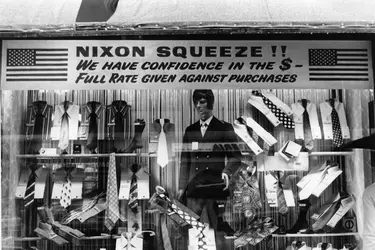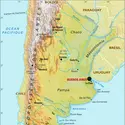DOLLAR
Bibliographie
A. I. Bloomfield, Monetary Policy under the International Gold Standard 1880-1914, Federal Reserve Bank of New York, 1959
W. A. Brown, The International Gold Standard Reinterpreted, 1914-1934, National Bureau of Economic Research, 2 vol., New York, 1940
L. V. Chandler, American Monetary Policy 1928-1941, Harper, New York, 1971
D. J. Cowen, The Origins and Economic Impact of the First Bank of the United States, 1791-1797, Garland, New York, 2000
S. V. O. Clarke, Exchange Rate Stabilization in the Mid-1930's : Negotiating the Tripartite Agreement, Princeton Studies in International Finance, no 41, 1977
R. Dehem, De l'étalon sterling à l'étalon dollar, Calmann-Lévy, Paris, 1972
E. Despres, C. P. Kindleberger & W. S. Salant, « The Dollar and world liquidity : a minority view », in The Economist, vol. 218, févr. 1966
B. Eichengreen, Golden Fetters : the Gold Standard and the Great Depression, 1919-1939, Oxford University Press, New York, 1992
M. Friedman, Money Mischief, Harcourt, Brace, Jovanovich, New York, 1992 (trad. franç., La Monnaie et ses pièges, Dunod, Paris, 1993)
M. Friedman & A. J. Schwartz, A Monetary History of the United Sates, 1867-1960, National Bureau of Economic Research, Princeton University Press, Princeton (N.J.), 1963
B. Hammond, Banks and Politics in America from the Revolution to the Civil War, Princeton University Press, Princeton (N.J.), 1957
P. H. Lindert, Key Currencies and Gold, 1900-1913, Princeton Studies in international studies, no 24, 1969
T. Mayer, Monetary Policy and the Great Inflation in the United States ; the Federal Reserve and the Failure of Macroeconomic Policy, 1965-1979, Edward Elgar, Cheltenham, 1999
R. Nurkse, L'Expérience monétaire internationale ; enseignements de la période d'entre les deux guerres, Société des Nations, Département économique, financier et du transit, Genève-New York, 1944
G. Ritter, Goldbugs and Greenbacks ; the Antimonopoly Tradition and the Politics of Finance in America, 1865-1896, Cambridge University Press, New York, 1997
H. Rockoff, « The Wizard of Oz as a monetary allegory », in Journal of Political Economy, août 1990
J. Rueff, Le Lancinant Problème des balances des paiements, Payot, Paris, 1965
P. Salin, Économie internationale, T. I : Économie financière, Armand Colin, Paris, 1974
R. H. Timberlake, Monetary Policy in the United States ; an Intellectual and Institutional History, Chicago University Press, Chicago (Ill.), 1993
R. Triffin, L'Or et la crise du dollar, P.U.F., Paris, 1965
T. Wilson, Battles for the Standard ; Bimetallism and the Spread of the Gold Standard in the Nineteenth Century, Ashgate, Aldershot (G.-B.), 2000
L. B. Yeager, International Monetary Relations : Theory, History and Policy, Harper & Row, New York, 1976.
La suite de cet article est accessible aux abonnés
- Des contenus variés, complets et fiables
- Accessible sur tous les écrans
- Pas de publicité
Déjà abonné ? Se connecter
Écrit par
- Dominique LACOUE-LABARTHE : professeur de sciences économiques à l'université de Bordeaux-IV-Montesquieu, directeur du Groupe de recherche en analyse et politique économiques, unité mixte du C.N.R.S. 5113
Classification
Pour citer cet article
Dominique LACOUE-LABARTHE. DOLLAR [en ligne]. In Encyclopædia Universalis. Disponible sur : (consulté le )
Médias
Autres références
-
ACCORDS DE BRETTON WOODS
- Écrit par Francis DEMIER
- 286 mots
- 1 média
Le système monétaire mis en place à Bretton Woods en 1944 répond, pour les Américains, à la volonté d'éviter les crises monétaires, dont on pensait qu'elles avaient entraîné le protectionnisme, le nationalisme, la guerre. Le système se présente comme un retour à l'étalon or qui, avec un système de...
-
AGRICOLE RÉVOLUTION
- Écrit par Abel POITRINEAU, Gabriel WACKERMANN
- 8 076 mots
« L'habitude s'est prise de désigner, sous le nom de révolution agricole, les grands bouleversements de la technique et des usages agraires qui, dans toute l'Europe, à des dates variables selon les pays, marquèrent l'avènement des pratiques de l'exploitation contemporaine » (Marc Bloch)....
-
ARGENTINE
- Écrit par Jacques BRASSEUL, Universalis, Romain GAIGNARD, Roland LABARRE, Luis MIOTTI, Carlos QUENAN, Jérémy RUBENSTEIN, Sébastien VELUT
- 37 033 mots
- 18 médias
...confiance des milieux financiers nationaux et internationaux. La mesure phare est la parité obtenue artificiellement entre le nouveau peso argentin et le dollar américain. Le plan semble fonctionner ; les petits épargnants croient à nouveau en leur monnaie et les institutions financières favorisent l'octroi... -
BRETTON WOODS CONFÉRENCE DE (1944)
- Écrit par Alain-Pierre RODET
- 963 mots
- 1 média
Du 1er au 22 juillet 1944, au moment où la Seconde Guerre mondiale prend fin, une conférence monétaire et financière, placée sous l'égide de ce qui va devenir bientôt l'Organisation des Nations unies, se tient sur la côte est des États-Unis à Bretton Woods (N.H.). Quarante-quatre...
- Afficher les 37 références
Voir aussi
- ÉTATS-UNIS D'AMÉRIQUE, droit et institutions
- SWAP, économie financière
- MARCHÉS DE CAPITAUX
- SYSTÈME MONÉTAIRE
- OR, économie et finances
- MÉTAUX PRÉCIEUX, histoire
- MUTATIONS MONÉTAIRES
- PAIEMENT MODES DE
- BANQUE HISTOIRE DE LA
- PARTI DÉMOCRATE, États-Unis
- INSTABILITÉ FINANCIÈRE
- BULLE SPÉCULATIVE
- RÉSERVES OBLIGATOIRES, économie bancaire
- CRISES BANCAIRES
- NOUVELLE ÉCONOMIE
- FRAPPE DE LA MONNAIE
- CHANGE FLOTTANT ou FLEXIBLE ou FLOTTEMENT MONÉTAIRE
- COMPENSATION BANCAIRE
- UNITÉ DE COMPTE
- ÉTATS-UNIS D'AMÉRIQUE, histoire, de 1865 à 1945
- POLITIQUE MONÉTAIRE
- MARCHÉ MONÉTAIRE
- POLITIQUE ÉCONOMIQUE
- PARITÉ MONÉTAIRE
- ÉTALON OR & ÉTALON DE CHANGE OR
- CROISSANCE ÉCONOMIQUE
- DÉPÔTS BANCAIRES
- ÉMISSION MONÉTAIRE
- RÉÉVALUATION
- COMMERCE EXTÉRIEUR POLITIQUE DU
- ÉTATS-UNIS D'AMÉRIQUE, histoire, de 1945 à nos jours
- ÉTATS-UNIS D'AMÉRIQUE, histoire, des origines à 1865
- ÉTATS-UNIS D'AMÉRIQUE, économie
- SME (système monétaire européen)
- ARGENT, monnaie
- SMI (système monétaire international)
- POLITIQUE BUDGÉTAIRE
- HISTOIRE ÉCONOMIQUE
- RELATIONS ÉCONOMIQUES INTERNATIONALES
- UNITÉ MONÉTAIRE
- EURODOLLARS





